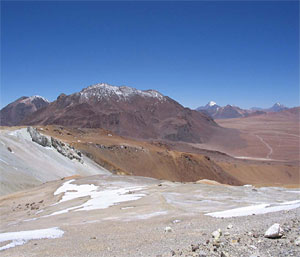
In February, a four-person scout team spent two weeks in Chile conducting initial site surveys and meeting with local contacts in preparation for phase two of the Radiative Heating in Underexplored Bands Campaign, or RHUBC-II. Planned to take place on the Chajnantor plateau between August and October 2009, this offsite field campaign will use spare ARM instruments, as well as guest instruments, to retrieve infrared radiation measurements across a broad portion of in the electromagnetic spectrum, including the elusive 17-100 µm and 6.7 µm regions. Combined with data from RHUBC in 2007, these hard-to-obtain measurements will be used to refine radiative calculations used in global climate models.
After their arrival in Santiago, the team spent two days meeting with Chilean government and administrators for the primary observatory on the Chajnantor plateau and talking with professors at the University of Chile. These contacts provided useful info about protocol, safety, and environmental conditions on the plateau. They then traveled to San Pedro de Atacama—the nearest town to the plateau—where they spent one day acclimating to the 2500-meter altitude and four days touring sites on the plateau and associated mountains at 5000-5650 meters. The team identified and prioritized potential sites based on scientific interest and operations feasibility, resulting in several very promising options.
The team also met with local technicians associated with the existing plateau observatories that will likely provide valuable assistance leading up to and during the deployment. The group then traveled to Valparaiso (an hours drive from Santiago) to meet with researchers associated with the plateau observatories before returning home. Based on their findings during this trip, the team will decide on a final deployment location and proceed with the necessary logistics arrangements.

